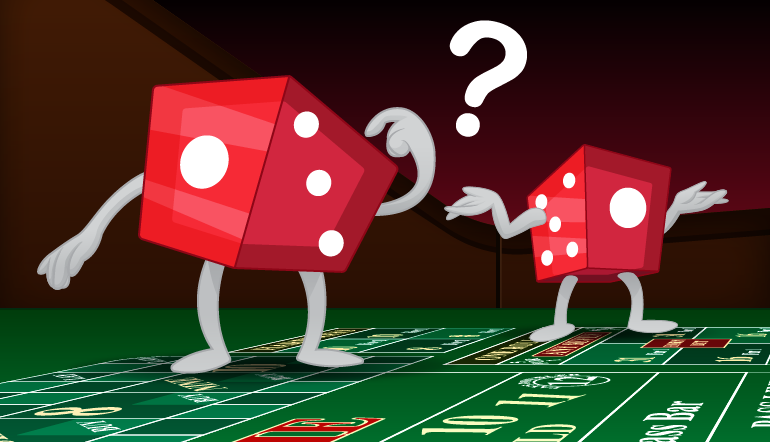Betting On Craps
Betting the come in craps confuses most players. Part of the reason for this is that the word “come” doesn’t convey much about the bet. Also, once the bet is made it often gets moved by the dealer, which adds to the confusion. But betting the come is not all that difficult to understand plus it happens to be one of the smartest bets you can make at craps.
A come bet is made after the shooter establishes a point number. How do you know when the latter happens? Easy, just look at the position of the button or puck as it’s called. That’s the large disk that you’ll find at the top of the layout. It’s black on one side (with the word OFF printed on it) and white on the other side (imprinted with ON). If the puck is located in a number box at the top of the layout with the on side facing up, this means that the shooter has established a point number and now it’s OK to make a come bet.
Key point: Only make a come bet when the puck is on and resting on a number box at the top of the layout.
You are probably wondering what happens to that little ole puck if it’s in the off rather than the on side. Good question. When the puck is on the off side (that’s the black side) it will be resting in the Don’t Come betting area which is located on the top right and left area of the layout. When it rests there this means that the next roll will establish the shooter’s point and it’s now time to make the come bet.
OK, now that you know when you should make the come bet, it’s time to explain how to make the bet. Actually, this is the easy part. Just reach across the table and place your chip(s) in the large boxed betting area in front of you that is labeled COME (you can’t miss it).
Now that you’ve made a come bet, you will win even money if the shooter tosses either a 7 or 11 on the next roll of the dice. You’ll lose if the next roll is a 2, 3 or 12. Pretty simple.
Key point: Come bet wins if the very next roll is a 7 or 11 (naturals) and loses on 2, 3, or 12 (craps numbers).
Now it’s time to get down and dirty and talk about what happens if the shooter tosses a number other than the winning 7 and 11 or losing 2, 3 and 12 numbers. After all, the shooter could throw a 4 or 6 or maybe a 10. Don’t panic because what happens is not all that difficult to understand.
Let’s suppose we make our come bet and the next roll is a 6. The dealer (not you) will pick up the chip(s) that you wagered in the come and move them inside the 6 point box at the top of the layout. It’s still your bet only it traveled from the come betting area, where you initially put it, up to the point box corresponding to the number that was thrown (in our example the 6). That number 6 is known as your come point number. Now that wasn’t too difficult.
Those chip(s) resting in the 6 point box are yours and you will win or lose the bet as follows:
- The shooter rolls the 6 again on subsequent rolls before throwing a 7 and you win even money or
- The shooter throws a 7 on any subsequent dice roll before throwing the 6 again and you lose.
So let’s get this straight. On the very next roll after you make a come bet you win if 7 or 11 is rolled and lose on 2, 3 or 12. If any other number is rolled, your bet travels to that number and wins if that number repeats again before a 7 and loses if the reverse happens, namely the 7 shows before the number repeats. In other words, come bets have two different “rules” for how they win or lose. For one roll only (immediately after you make the bet) you win if 7 or 11 is thrown and lose on 2, 3 or 12. But if your bet travels up to point box, you win when the come point number is rolled again before the 7 (and lose if the 7 shows before the come point number repeats). It may take several dice throws to determine the outcome of your come point number.
Notice that the number 7 is like a dual-edge sword. If it’s thrown immediately after you make a come bet you win. However, if it is rolled after your come bet travels to a point number, you lose. Interesting.
Key Point: If a point number is thrown, your come bet travels to the corresponding point box and wins if the number repeats before a 7 and loses if 7 shows before the come point number.
Let’s try a few examples of dice throws so you get the hang of this. Suppose you walk up to a table and notice that the puck is on the on side (white side). Before the dealer pushes the dice to the shooter with his stick, you place a $5 chip in the come. The next sequence of dice tosses is:
5 2 11 9 6 5

